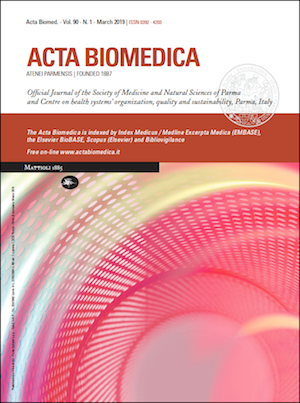Evaluation of alpha-1-antitrypsin levels in blood serum of patients with chronic obstructive pulmonary disease
Keywords:
alpha-1 antityrpsin level, chronic obstructive pulmonary diseaseAbstract
Introduction: Chronic obstructive pulmonary disease (COPD) is a disease that causes obstructed air flow from the lungs. The disease also has a dramatic role in increasing rate of mortality and morbidity in recent years. Air pollution, long-term exposure to particulate matter and irritating gases, especially cigarette smoke, genetic inheritance which has an impact on the initial forced expiratory volume one in second (FEV1), and alpha-1-antitrypsin (AAT) deficiency are among common COPD risk factors. The objective of this study is to evaluate parameters and serum AAT levels in COPD patients. Materials and Methods: Having taken the approval of local ethical committee, this cross-sectional study was performed with adult patients diagnosed with COPD, whose serum AAT levels were measured through nephelometric analysis in Kars Harakani State Hospital where secondary health care is served. The study evaluated ATT levels in patients’ serum in relation to their age, gender, body mass (BMI), exposure to cigarette smoke, FEV1 percentage, hospitalization in pulmonology or intensive care unit through a year, mortality status, white blood cell (WBC), c-reactive protein (CRP) and blood gases. Results: The average age of the 243 patients included in the study was 68.41±11.52 and 160 (65.8%) of them were male. The age and BMI of the female patients were higher. Of the all patients only a single patient’s serum AAT level was below the reference value. AAT levels were similar in both genders irrespective of their being exposed to cigarette smoke or being discharged or being exitus at their first admission to hospital, being exitus in the first year of disease diagnose, and being hospitalized in intensive care unit. AAT levels were reasonably correlated with WBC and CRP in a positive way (p<0.001 r=0.289 for WBC; p<0.001, r=0.295 for CRP). AAT levels were seen to significantly increase along with COPD stages which go up with FEV1 percentages (p<0.001). CRP was watched to have increased to Stage III COPD (severe COPD). However, it was watched to have decreased in Stage IV (very severe COPD) (p =0.179). Conclusion: In the study, AAT serum levels of COPD patients were examined. The levels and their relations in various parameters of the patients were evaluated.
Downloads
Published
Issue
Section
License
This is an Open Access article distributed under the terms of the Creative Commons Attribution License (https://creativecommons.org/licenses/by-nc/4.0) which permits unrestricted use, distribution, and reproduction in any medium, provided the original work is properly cited.
Transfer of Copyright and Permission to Reproduce Parts of Published Papers.
Authors retain the copyright for their published work. No formal permission will be required to reproduce parts (tables or illustrations) of published papers, provided the source is quoted appropriately and reproduction has no commercial intent. Reproductions with commercial intent will require written permission and payment of royalties.







